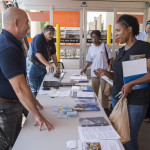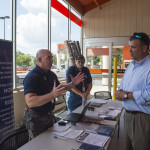CHICAGO –Join National PrepareAthon! Day on September 30 and take action to improve your emergency preparedness and resilience to disasters. America’s PrepareAthon! is a grassroots campaign developed to encourage individuals, organizations and communities to prepare for specific hazards through drills, group discussions and exercises.
“It’s important to be proactive about emergency preparedness so you know what to do if disaster strikes,” said FEMA Region V Administrator Andrew Velasquez III. “Engage your family, friends and neighbors to identify the risks in your community and understand what to do to stay safe.”
-
Sign up for local alerts and warnings and check for access to wireless emergency alerts. Visit the websites for your city and/or county to find out if they offer emergency alert notifications. You should also ensure your cell phone is enabled to receive Wireless Emergency Alerts (WEA) to warn you of extreme weather and other emergencies in your area. Remember, warning sirens are intended for outdoor notification. When indoors, your alert-enabled smart phone or weather radio can provide you with critical alerts.
-
Develop and test emergency communications plans. Visit www.Ready.gov/plan-for-your-risks for tips on how to ensure your plan is as comprehensive as possible.
-
Assemble or update emergency supplies. Include drinking water, a first-aid kit, canned food, a radio, flashlight and blankets. Visit www.Ready.gov/build-a-kit for a disaster supply checklist. Don’t forget to store additional supply kits in your car and at the office.
-
Collect and safeguard critical documents. Make copies of important documents (mortgage papers, deed, passport, bank information, etc.). Keep copies in your home and store originals in a secure place outside the home, such as a bank safe deposit box.
-
Document property and obtain appropriate insurance for relevant hazards. Discuss with your insurance agent the risks that may threaten your home and the types of coverage you may need to ensure your property is adequately insured.
-
Download the FEMA app to your smartphone. You’ll receive alerts from the National Weather Service for up to five locations across the U.S. and have access to information about how to stay safe.
More information about the ways to register for and participate in America’s PrepareAthon! Day is available at www.Ready.gov/prepare. For even more readiness information, follow FEMA Region V at twitter.com/femaregion5 and facebook.com/fema.
Follow FEMA online at twitter.com/femaregion5, www.facebook.com/fema, and www.youtube.com/fema. Also, follow Administrator Craig Fugate’s activities at twitter.com/craigatfema. The social media links provided are for reference only. FEMA does not endorse any non-government websites, companies or applications.
FEMA’s mission is to support our citizens and first responders to ensure that as a nation we work together to build, sustain, and improve our capability to prepare for, protect against, respond to, recover from, and mitigate all hazards.
###
Media Contact: Cassie Ringsdorf, 312-408-4455
Original link –
Take Action and Be Disaster Ready: National PrepareAthon! Day






